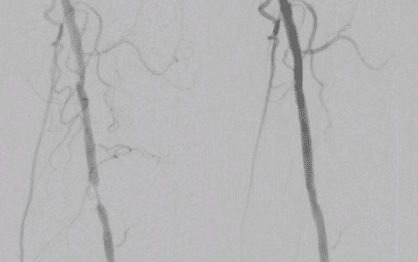Walking leg pain is called claudication. If you or someone you care about experiences leg pain when walking, it can be challenging to diagnose, but there are minimally invasive treatments that can help. Our doctors will determine the cause of leg pain and get to the root of the problem.
There are many types of leg pain, all of which have different causes. Vascular claudication is leg pain caused by a blocked artery and is often a symptom of peripheral artery disease (PAD). Neurogenic claudication, on the other hand, is caused by degenerative changes in the spine and has slightly different symptoms. If it is determined that a patient is experiencing vascular claudication, they are a candidate for our treatment.
What is claudication?
Pain in the thigh, calf, or buttock when walking can have many causes, including problems with bones, joints, nerves, muscles, arteries, and veins. Claudication may indicate peripheral arterial disease (PAD), increasing the patient’s risk of heart attack and stroke. If left untreated, PAD can progress to chronic limb-threatening ischemia (CLTI), which can lead to ulcers and potential amputation. Fortunately, we diagnose and treat these often unrecognized issues with highly effective, minimally invasive procedures.
What are some of the risk factors for claudication?
VIE provides treatments for patients diagnosed with vascular claudication and PAD.
The first step in treating patients diagnosed with PAD is to reduce the risk of future vascular problems, including stroke and heart attack, through medical management and risk factor reduction.
Initial treatment includes:
Improving blood flow includes:
Improving blood flow through endovascular or open vascular procedures is used when patients’ walking distance does not improve after medical and exercise therapy.
How is endovascular treatment performed?
A local anesthetic is administered, and access to the artery is achieved through a small skin incision. After performing an angiogram (taking pictures of the arteries) wires and catheters are used to reach the area of narrowing or blockage. Treatment can include one or more of the following:
The best treatment course is determined based on various factors. Once treatment is completed, all equipment is removed (except for any stents). A closure device may be used to seal the hole in the artery. The incision is tiny, so stitches are usually not needed.
What are the benefits of endovascular treatment?
The procedures are minimally invasive and quickly and effectively restore blood flow without the risks associated with surgery. By restoring normal flow, symptoms are immediately improved, and the long-term complications of claudication are reduced.
Am I a candidate for endovascular treatment?
The doctors at VIE will ask questions to understand the causes of your leg pain and get to the root of the problem. We are here to help evaluate your symptoms and determine whether endovascular treatment suits you.
After your procedure, you’ll spend about an hour in a comfortable recovery room before heading home that day. Expect minimal discomfort no limitations on your activities, allowing you to resume your daily routine as soon as you feel ready. Most patients notice an immediate improvement when walking, with continued improvement for one to three months. Our team will be here to support you, ensuring a smooth and speedy recovery.

Figure 1.Blockage in a leg artery fixed with atherectomy and angioplasty.


Phone: 952.838.0650
Fax: 952.838.0651
Hours: 7 AM – 4 PM (M – F)
© 2024 Vascular & Interventional Experts